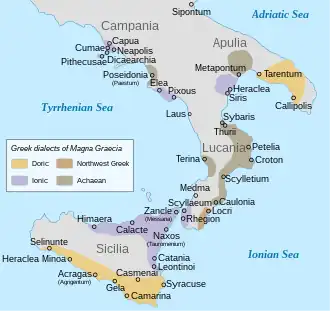
This article lists kings of Thrace and Dacia, and includes Thracian, Paeonian, Celtic, Dacian, Scythian, Persian or Ancient Greek up to the point of its fall to the Roman Empire, with a few figures from Greek mythology.
Mythological
- Haemus, became a mountain Haemus Mons
- Thrax, son of Ares
- Tegyrios, mortal
- Eumolpus, inherited a kingdom from Tegyrios
- Tereus, the king that was turned into a hoopoe[1]
- Phineus, Phoenician son of Agenor, blind king and seer[2]
- Poltys, son of Poseidon[3]
- Pyreneus, died trying to harm the Muses
- Harpalykos,[4] king of the Amymnaeans
- Thoas, founder of Thoana
- Mopsus, killed Myrine, an amazon queen
- Peirous, a Thracian war leader[5] killed by Thoas the Aetolian
- Rhesus of Thrace, died in the Trojan war[6]
- Cisseus, father of Theano, the wife of Antenor
- Diomedes of Thrace, Giant that ruled over the Bistones
- Lycurgus, of the Edoni
- Oeagrus, father of Orpheus and Linus
- Orpheus[7] of the Cicones
- Polymestor of the Bistonians[8]
- Zalmoxis of the Getae
- Charnabon of the Getae, who came into power when grain was first given to men[9] mentioned by Sophocles[10]
- Pyraechmes of the Paeonians
- Asteropaios of the Paeonians
Persian
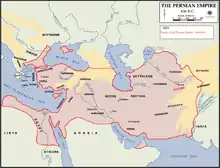
Tribal kings
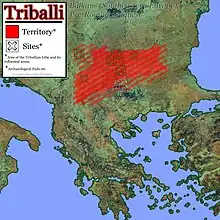
- Olorus, 5th century BC[12]
- Syrmus, king of the Triballi[13] 4th century BC
- Bergaios, petty king of Pangaeum
- Dromichaetes, of the Getae 300 BC
- Langarus, of the Agrianes
- Pleuratus, a Thracian or Illyrian king that attacked Tylis 213–208 BC
- Diegylis, chieftain of the Caeni extremely bloodthirsty 145 BC
- Ziselmius, Diegylis' son
- Mostis, of the Caeni, king ~130–90 BC
- Abrupolis of the Sapaeans, 2nd century BC
- Rabocentus[14] of the Bessi mentioned by Cicero
- Cosingas,[15] chieftain and priest of Hera to the tribes of Cebrenii and Sucaeboae
- Getas, king[16][17] of the Edones
Getic and Dacian

- Charnabon, king of the Getae as mentioned by Sophocles in Triptolemus - 5th century BC
- Cothelas,[18] father of Meda of Odessa – 4th century BC
- Rex Histrianorum, ruler in Histria, mentioned by Trogus Pompeius and Justinus - 339 BC
- Dual – 3rd century BC
- Moskon[19] – 3rd century BC
- Dromichaetes[20] – 3rd century BC
- Zalmodegicus[21] – around 200 BC[22]
- Rhemaxos – around 200 BC[23][24]
- Rubobostes[25] – around 200 BC
- Zoltes - 200 BC [26]
- Oroles[27] – 2nd century BC
- Dicomes[28] – 1st century BC
- Rholes[29] – 1st century BC
- Dapyx[30] – 1st century BC
- Zyraxes[31] – 1st century BC
- Burebista[32] – 82–44 BC
- Deceneus[33] – 44 BC - around 27 BC High Priest
- Thiamarkos - 1st century BC - 1st century AD, Dacian king (inscription "Basileys Thiamarkos epoiei")[34]
- Cotiso[35] – c. 40 BC - c.9 BC
- Comosicus[36] – 9 BC–30 AD
- Scorilo[36] – c.30–70 AD
- Coson[37]
- Duras[37] – c. 69–87
- Decebalus[38] – 87–106
- 106 AD, Dacia becomes a province of the Roman Empire conquered by Trajan.
- Pieporus, king of Dacian Costoboci – 2nd century AD (inscription)[39][40]
- Tarbus – 2nd century AD. Dio Cassius mentioned him without specifying his origin. Some authors consider a possible Dacian ethnicity[41][42]
Paeonian
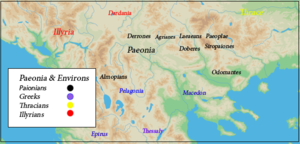
Celtic rulers in Thrace
Celtic rulers of Tylis in Thrace[47]
- Comontorius Celtic military commander, first king of Tylis (c. 277 BC-?)
- Orsoaltius (presumed Celtic on the basis of coin types; order uncertain)
- Cersibaulus (presumed Celtic on the basis of coin types; order uncertain)
- Cavarus, last king of Tylis; overthrown by the Thracians (?-212 BC)[48]
Macedonian

- Philip II of Macedon, annexed Thrace, 341–336 BC
- Alexander the Great retains Thrace and suppresses rebellion, 335–323 BC
- Lysimachus, one of the Diadochi, includes Thrace in his kingdom, 323–281 BC[49][50]
- Philip V of Macedon controls all cities of Thrace up to the hellespont,[51] 238–179 BC
- Perseus of Macedon continues controlling the part of Thrace his father left him, 212–166 BC
Odrysian Kingdom
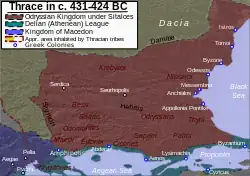
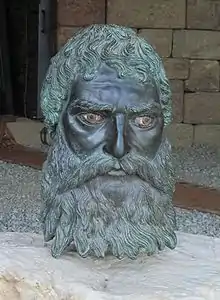
The list below includes the known Odrysian kings of Thrace, but much of it is conjectural, based on incomplete sources, and the varying interpretation of ongoing numismatic and archaeological discoveries. Various other Thracian kings (some of them non-Odrysian) are included as well.[52] Odrysian kings though called Kings of Thrace never exercised sovereignty over all of Thrace.[53] Control varied according to tribal relationships.[54] Odrysian kings (names are presented in Latin forms):
- Teres I, son of ? Odryses, (480[55]/450/430 BC[56])
- Sparatocus, son of Teres I (c. 465?-by 431 BC)
- Sitalces, son of Teres I (by 431-424 BC)
- Seuthes I, son of Sparatocus (424-396 BC)
- Maesades, father of Seuthes II, local ruler in eastern Thrace?
- Teres II, local ruler in eastern Thrace
- Saratocus (= Sadocus, son of Sitalces?), local ruler in western Thrace?
- Metocus (= Amadocus I?), son of ? Sitalces
- Amadocus I, son of ? Metocus (unless identical to him) or of Sitalces (by 405[57]-after 390 BC)
- Seuthes II, son of Maesades, descendant of Teres I, local ruler in eastern Thrace (by 405?-after 387 BC)
- Hebryzelmis, son or brother of ? Seuthes I (c. 386 BC)
- Cotys I, son of ? Seuthes I[58] or Seuthes II[59] (by 384–360 or 359 BC)
- Cersobleptes, son of Cotys I, king in eastern Thrace (360 or 359-341 BC)
- Berisades, rival of Cersobleptes, king in western Thrace in Strimos (359-352 BC)
- Amadocus II, son of Amadocus I and rival of Cersobleptes, king in central Thrace in Chersonese and Maroneia (359-351 BC)
- Cetriporis, son of Berisades, king in western Thrace in Strimos (358-347 BC)
- Teres III, son of ? Amadocus II, king in central Thrace in Chersonese and Maroneia (351-342 BC)
- The kings of Thrace are forced to submit to Macedonian rule or overlordship by 341 BC
- Seuthes III, son of ? Teres III[60] or Cotys I, opposed Macedonian rule (by 324–after 312 BC)
- The succession to Seuthes III is unclear; the area was partitioned among Thracian dynasts and Macedonian kings, after 277 also by the Celts of Tylis
Odrysian rulers in eastern Thrace (hypothetical reconstruction[61])
Odrysian rulers originally in inner Thrace (hypothetical reconstruction[63])
- Teres IV, son of Seuthes (III?) (c. 295 BC?)
- Seuthes IV, son of Teres (IV?)
- Teres V, son of ? Seuthes IV (c. 255 BC)
- Rhoegus, son of Seuthes (IV?) (mid-Third Century, buried in the Thracian Tomb of Kazanlak)
- Seuthes V, son of ? Rhoegus
- Amadocus III, son of ? Seuthes V (c. 184 BC)
- Cotys IV, son of Seuthes V (by 171-after 166)
- Teres VI, son of ? Amadocus III (c. 148 BC)
- Beithys (Bithys), son of Cotys IV (c.146 BC?)
- The line may have continued as the Odryso-Astaean dynasty listed below
Various Thracian local rulers attested in the Third Century BC[64]
- Spartocus, ruler of Cabyle? (c. 295 BC)
- Scostocus, ruler in southern Thrace near Aenus and Sestus (c. 280-after 273 BC)
- Sadalas, ruler near Messembria (c. 275 BC), descendant of Cotys, Medistas, Taruntinus, and Mopsyestis (order and relationships unknown)
- Odoroes (c. 280-273 BC) (?)
- Adaeus, Thracian or Macedonian ruler near Cypsela (c. 260-c. 240 BC)
Various non-Odrysian rulers in Thrace[65]
- Abrupolis of the Sapaeans, fought with Antigonid Macedonia (by 197-172 BC)
- Autlesbis of the ? Caeni, fought with Cotys IV as Roman ally (c. 168 BC)
- Diegylis of the Caeni (by 150-after 144 BC)
- Zibelmius of the Caeni, son of Diegylis, murdered (c. 141 BC)
- Sothimus of the ? Maedi, ally of Mithradates VI, invaded Roman Macedonia (c. 89 BC)
Illyrian rulers[66]
- Pleuratus I ruler near Skodra (before c. 250 BC)
- Agron, son of Pleuratus II (c. 250-230 BC)
- Pinnes, son of Agron (230-212 BC); under regency of stepmother Teuta 230-228 BC and of stepfather Demetrius of Pharos 228-219 BC
- Scerdilaidas, son of Pleuratus I (212-206 BC)
- Pleuratus II, son of Scerdilaidas (associated 212, 206-180 BC)[67]
- Gentius (Genthius), son of Pleuratus II (180-168 BC)
- 168 BC Illyria annexed by the Roman Republic
Odryso-Astaean Kingdom

A possible continuation of the earlier Odrysian monarchy under a line of kings reigning from Bizye (now Vize) in eastern Thrace.[68]
- Cotys V, son of ? Beithys (?-by 87 BC)
- Sadalas I, son of Cotys V (by 87–after 79 BC)
- Amadocus, Odrysian royal sent to the aid of Sulla at Chaeronea in 86 BC
- Cotys VI, son of Sadalas I (by 57–48 BC)[69]
- Sadalas II, son of Cotys VI (48–42 BC)
- Sadalas III, kinsman of Sadalas II (42-31 BC)
- Cotys VII, son of Sadalas II by Polemocratia (31–18 BC)
- Rhescuporis II (Astaean), son of Cotys VII by daughter of the Sapaean king Cotys II, killed by the Bessi (18–11 BC)
- 11 BC Astaean Thrace conferred on Rhescuporis II's maternal uncle, the Sapaean king Rhoemetalces I, by the Roman emperor Augustus, thereby uniting Thrace[70]
Sapaean Kingdom and unified Thrace

Originally a local power in the Rhodope area of southern Thrace, the Sapaean kings increased in power and influence and, with Roman blessing, found themselves masters of a unified kingdom of Thrace from 11 BC until the Roman annexation in AD 46. [71]
- Cotys I, son of ? Rhoemetalces, 57?–by 48 BC
- Rhescuporis I, son of Cotys I, by 48 BC–41 BC
- Rhascus, son of Cotys I, associate ruler? c. 42 BC
- Cotys II, son of Rhescuporis I, 42 BC–31 BC
- Thrace becomes a unitary client state of Rome in 11 BC[72]
- Rhoemetalces I, son of Cotys II, 31 BC–AD 12 (monarch of all Thrace from 11 BC)[73]
- Rhescuporis II, son of Cotys II, in western Thrace, deposed by the Roman emperor Tiberius I, 12–19
- Cotys III, son of Rhoemetalces I, in eastern Thrace, killed by his uncle Rhescuporis II, 12–19; married Antonia Tryphaena
- Rhoemetalces II, son of Cotys III and Antonia Tryphaena, 19-38
- Antonia Tryphaena (Queen), co-ruler of her son Rhoemetalces II[74]
- The last client rulers of Thrace: Pythodoris II (Queen) and Rhoemetalces III;[75] Rhoemetalces III, son of Rhescuporis II, 38-46; married his cousin's daughter Pythodoris II (daughter of Cotys III and Antonia Tryphaena), murdered by wife
- 46 annexation by the Roman Empire, by the Roman emperor Claudius I
Scythian
See also
Notes
- ↑ Tereus, "Tereus 1 is the cruel Thracian king who helped King Pandion 2 of Athens in his war against King Labdacus 1 of Thebes, and having received one of his daughters seduced the other"
- ↑ Phineus, "Phineus is the blind king and seer"
- ↑ Poltys, "Poltys. An Aenian who entertained Heracles when he came to Aenus in Thrace. He was son of Poseidon [Apd.2.5.9]."
- ↑ Harpalyce(Ἁρπαλύκη)., "1. A daughter of Harpalycus, king of the Amymnaeans in Thrace. As she lost her mother in her infancy, she was brought up by her father with the milk of cows and mares, and was trained in all manly exercises. After the death of her father, whom she had once delivered from the hand of the Myrmidons, she spent her time in the forests as a robber, being so swift in running that horses were unable to overtake her. At length, however, she was caught in a snare by shepherds, who killed her. (Serv. ad Virg. Aen. 1.321; Hyg. Fab. 193.)"
- ↑ Peiros, Peiros. Thracian leader, son of Imbrasus and father of Rhigmus. He was killed by Thoas, Leader of the Aetolians (Hom.Il.4.520ff., 20.484ff.).
- ↑ Rhesus Rhesus 2 is chiefly remembered because he came from Thrace to defend Troy with great pomp and circumstance, but died on the night of his arrival, without ever engaging in battle.
- ↑ Carlos Parada, "Orpheus, king of the Ciconians"
- ↑ Polymestor, "Polymestor 1 (Polymnestor). This is the king of the Bistonians in Thrace"
- ↑ Carnabon, "Carnabon. King of the Getae in Thrace who came into power when grain was first given to men [see also Lyncus, and CONSTELLATIONS] [Hyg.Ast.2.14]."
- ↑ Dacia: Landscape, Colonization and Romanization by Ioana A Oltean, 2007, page 41: "... Trixae and Sophocles (Triptolem, FR 547) mentions a local king, Charnabon, as a typical anti-hero."
- ↑ The Oxford Classical Dictionary by Simon Hornblower and Antony Spawforth, ISBN 0-19-860641-9, page 1515, "The Thracians were subdued by the Persians by 516"
- ↑ The Histories by Herodotus, John M. Marincola, and Aubery de Selincourt, page 373: "... 500 mercenaries, and married Hegesipyle, daughter of the Thracian King Olorus."
- ↑ Plutarch's Lives by Plutarch, 2008, ISBN 1-4404-1432-7, page 183: "... Danube, and by winning a signal victory over Syrmus, the King of the Triballi. After this, as he heard that the Thebans had revolted, ..."
- ↑ The Oxford Classical Dictionary by Simon Hornblower and Antony Spawforth, 2003, page 1515: "... *Calpurnius Piso Caesoninus, and *Cicero calls Rabocentus, chief of the Bessi, a faithful ally, although hitherto they had been troublesome ..."
- ↑ Polyaenus: Stratagems - BOOK 7, The generals of the Cebrenii and Sycaeboae, two Thracian tribes, were chosen from among the priests of Hera. Cosingas, according to the tradition of the country, was elected to be their priest and general; but the army took some objection to him, and refused to obey him. To suppress the rebelliousness that had taken hold of the troops, Cosingas built a number of long ladders, and fastened them one to another. He then put out a report, that he had decided to climb up to heaven, in order to inform Hera of the disobedience of the Thracians. The Thracians, who are notoriously stupid and ridiculous, were terrified by the idea of their general's intended journey, and the resulting wrath of heaven. They implored him not to carry out his plan, and they promised with an oath to obey all of his future commands.
- ↑ The Odrysian Kingdom of Thrace: Orpheus Unmasked (Oxford Monographs on Classical Archaeology) by Z. H. Archibald, 1998, ISBN 0-19-815047-4, page 106
- ↑ Ancient Coins of Greek Cities and Kings: From Various Collections Principally in Great Britain by James Millingen, 2004, page 42: "... silver mines so renowned in history. A coin of Geta, king of the Edones, with the legend FETAI HAONEON BAIIAEYI of the same types, ..."
- ↑ Atlas of Classical History by R. Talbert, 1989, page 63, "Getae under Cothelas"
- ↑ https://revistapontica.files.wordpress.com/2012/02/pontica-3-pag-125-129.pdf Radu Ocheșeanu: Monedele basileului Moskon aflate în colecțiile Muzeului de Arheologie Constanța
- ↑ Dacia: Landscape, Colonization and Romanization by Ioana A Oltean, 2007, Index Dromichaetes King of the Getians
- ↑ McGing B.C.: The foreign policy of Mithridates VI Eupator, King of Pontus
- ↑ Kurt W. Treptow and Ioan Bolovan in “A history of Romania - East European Monographs”, 1996, ISBN 9780880333450, page 17 "..Two inscriptions discovered at Histria indicate that Geto-Dacian rulers (Zalmodegikos and later Rhemaxos) continued to exercise control over that city-state around 200 BC ...."
- ↑ The Hellenistic Age from the Battle of Ipsos to the Death of Kleopatra VII by Stanley M. Burstein, 1985, Index Rhemaxos Getic or Scythian ruler
- ↑ Kurt W. Treptow and Ioan Bolovan in “A history of Romania - East European Monographs”, 1996, ISBN 9780880333450, page 17 "Two inscriptions discovered at Histria indicate that Geto-Dacian rulers (Zalmodegikos and later Rhemaxos) continued to exercise control over that city-state around 200 BC ...."
- ↑ Dacia: Landscape, Colonization and Romanization by Ioana A Oltean, 2007, Index Rubobostes Dacian King
- ↑ Theodossiev, Nikola (2010). "Thrace". In Gagarin, Michael (ed.). The Oxford Encyclopedia of Ancient Greece and Rome. Vol. 1. Oxford University Press. p. 55. ISBN 978-0-19-517072-6. Retrieved 22 December 2013.
- ↑ Dacia: Landscape, Colonization and Romanization by Ioana A Oltean, 2007, page 53, "Dacian King Oroles"
- ↑ Dacia: Landscape, Colonization and Romanization by Ioana A Oltean, 2007, page 47, "Dicomes of the Getians"
- ↑ The Roman History: The Reign of Augustus by Cassius Dio, Ian Scott-Kilvert, and John Carter, 1987, page 85: "... Then he completed their destruction with the help of Roles, the king of a tribe of the Getae. When Roles visited Octavian, he was treated as a friend ..."
- ↑ Cassius Dio. Roman History, Book LI. "While he was thus engaged, Roles, who had become embroiled with Dapyx, himself also king of a tribe of the Getae, sent for him. Crassus went to his aid, and by hurling the horse of his opponents back upon their infantry he so thoroughly terrified the latter also that what followed was no longer a battle but a great slaughter of fleeing men of both arms. Next he cut off Dapyx, who had taken refuge in a fort, and besieged him. In the course of the siege someone hailed him from the walls in Greek, obtained a conference with him, and arranged to betray the place. The barbarians, thus captured, turned upon one another, and Dapyx was killed along with many others. His brother, however, Crassus took alive, and not only did him no harm but actually released him."
- ↑ Dacia: Landscape, Colonization and Romanization by Ioana A Oltean, 2007, page 146, "Zyraxes who ruled in Dobruja"
- ↑ Studies in Ancient Greek and Roman Society by Robin Osborne, 2004, page 128: "... of its citizens, named Akornion, went on an embassy to Burebista, the first and greatest of the kings in Thrace..."
- ↑ Dacia: Landscape, Colonization and Romanization by Ioana A Oltean, 2007, Index (Decaeneus/Dekaineus/Dicineus) Dacian High priest"
- ↑ Berciu 1981, p. 139-140.
- ↑ Dacia: Landscape, Colonization and Romanization by Ioana A Oltean, 2007, page 48, "The Dacian king Cotiso"
- 1 2 Dacia: Landscape, Colonization and Romanization by Ioana A Oltean, 2007, page 72, "At least two of his successors Comosicus and Scorillo/Corilus/Scoriscus became high priests and eventually Dacian kings"
- 1 2 Dacia: Landscape, Colonization and Romanization by Ioana A Oltean, 2007, page 47, "Kings Coson (who minted his own coins) and Duras"
- ↑ De Imperatoribus Romanis . Retrieved 2007-11-08. "In the year 88, the Romans resumed the offensive. The Roman troops were now led by the general Tettius Iulianus. The battle took place again at Tapae but this time the Romans defeated the Dacians. For fear of falling into a trap, Iulianus abandoned his plans of conquering Sarmizegetuza and, at the same time, Decebalus asked for peace. At first, Domitian refused this request, but after he was defeated in a war in Pannonia against the Marcomanni (a Germanic tribe), the emperor was obliged to accept the peace."
- ↑ Wilhelm Tomachek in “Les restes de la langue dace” published in “Le Muséon By Société des lettres et des sciences, Louvain, Belgium, page 407 "Pieporus, prince des daces Costoboces..."
- ↑ Gudmund Schütte in Ptolemy's maps of northern Europe, H. Hagerup, 1917 page 82 "historical king Pieporus. The same author Schütte in “Our forefathers” published by University Press, 1929 page 74 "The North Dacian tribes of the Koistobokoi and Karpoi unlike the rest of Dacia escaped the Roman conquest of AD 105..."
- ↑ Wilhelm Tomachek (1883): “Les restes de la langue dace” published in “Le Muséon By Société des lettres et des sciences, Louvain, Belgium, page 409
- ↑ Batty, Roger (2007): Rome and the Nomads: the Pontic-Danubian realm in antiquity, Oxford University Press, ISBN 0-19-814936-0, ISBN 978-0-19-814936-1, page 366
- ↑ The Oxford Illustrated History of Prehistoric Europe (Oxford Illustrated Histories) by Barry Cunliffe, 2001, page 380
- ↑ Strabo, Geography(7.5.2), "A part of this country was laid waste by the Dacians when they subdued the Boii and Taurisci, Celtic tribes under the rule of Critasirus"
- ↑ The Ancient Celts by Barry Cunliffe, ISBN 0-14-025422-6, 2000, page 86: "... distinguished suggests that one of the returning groups, led by Bathanatos, finally settled in the Middle Danube region at the confluence ..."
- ↑ Celts - a History, The by Daithi O HOgain, ISBN 1-905172-20-6, 2006, page 60, "... those who, on their return from Greece under their leader Bathanatos, had settled at the confluence of the Danube and the ..."
- ↑ Mladjov, Thracian Kings, University of Michigan. Compare Werner 1961: 115, 239
- ↑ Celts and the Classical World by David Rankin, ISBN 0-415-15090-6, 1996, page 189: "According to Polybius, the last of the kings of Tylis, Cavarus, was a man of magnanimity and regal character" (8.24).
- ↑ Heckel, Waldemar. Who's Who in the Age of Alexander the Great: Prosopography of Alexander's Empire. Blackwell Publishing, 2006, ISBN 1-4051-1210-7, p. 155. "In 306 or 305, he assumed the title of "King", which he held until his death at Corupedium in 282/1."
- ↑ Heckel, Waldemar. Who's Who in the Age of Alexander the Great: Prosopography of Alexander's Empire. Blackwell Publishing, 2006, ISBN 1-4051-1210-7, p. 155. "In 323 Lysimachus was assigned control of Thrace, and was probably strategos rather than satrap. The subordinate position of strategos may account for the failure of the sources to mention Lysimachus in the settlement of Triparadeisus; his brother Autodicus was, however, named as a Somatophylax of Philip III at that time
- ↑ The Thracians 700 BC-AD 46 by Christopher Webber, ISBN 1-84176-329-2, 2001, page 11, "Philip V of Macedon occupied all the cities in Thrace up to the Hellespont, "
- ↑ Mladjov, Thracian Kings, University of Michigan. Compare Werner 1961: 111-114, 239-240; Topalov 1994.
- ↑ The Odrysian Kingdom of Thrace: Orpheus Unmasked (Oxford Monographs on Classical Archaeology) by Z. H. Archibald,1998, ISBN 0-19-815047-4, page 105
- ↑ The Odrysian Kingdom of Thrace: Orpheus Unmasked (Oxford Monographs on Classical Archaeology) by Z. H. Archibald,1998, ISBN 0-19-815047-4, page 107
- ↑ Mladjov, Thracian Kings, University of Michigan.
- ↑ Thrace. The History Files.
- ↑ Smith, William (1867). "Amadocus (I)". In William Smith. Dictionary of Greek and Roman Biography and Mythology 1
- ↑ Topalov 1994
- ↑ Archibald 1998
- ↑ Topalov 2001: 272-278
- ↑ Mladjov, Thracian Kings, University of Michigan. Compare Werner 1961: 114-115, 239
- ↑ Manov 2015 dates the coins and inscription naming "Rhescuporis son of Cotys" to the beginning of the First Century AD and argues that they are the Sapaean Cotys III and his uncle Rhescuporis II/III. While a later date for this Rhescuporis and his father Cotys may be advisable (and therefore this Cotys would be distinct from Cotys son of Rhaezdus), Manov's hypothesis contradicts the father-son relationship between Cotys and Rhescuporis in the sources.
- ↑ Mladjov, Thracian Kings, University of Michigan, who also gives an alternative sequence should Rhoegus be placed in the early Third Century BC: "But if Roigos is dated to the early 3rd century and was a son of Seuthēs III (e.g., Kojčev 2008), the pedigree and succession could be restored as follows: Seuthēs III–Roigos–Seuthēs IV–Tērēs IV–Seuthēs V; our Tērēs VI would become Tērēs V." Compare Werner 1961: 114-117, 239.
- ↑ Jurukova 1992: 105-152.
- ↑ Werner 1961: 115-119, 239.
- ↑ Werner 1961: 90-93, 241.
- ↑ The History Of Rome by Livy, 2004, ISBN 1-4191-6629-8, page 27: "Pleuratus and Scerdilaedus might be included in the treaty. Attalus was king of Pergamum in Asia Minor; Pleuratus, king of the Thracians;
- ↑ Mladjov, Thracian Kings, University of Michigan; Werner 1961: 117-119, 239, 242; Sullivan 1990: 25-30, 145-151, stemma 1.
- ↑ Kessler, P L. "Kingdoms of Greece - Sapes (Thrace)". www.historyfiles.co.uk.
- ↑ Tačeva 1997: 83-95, 246-247, develops an alternative to the long-dominant reconstruction of the political, chronological, and genealogical relationships reflected in this list (established by Dessau in 1913 and widely accepted, e.g., Sullivan 1990), having the Odrysian-Astaean line end with Sadalas II in 42 BC, making Cotys VII the brother (not brother-in-law) of the Sapaean Rhoemetalces I, and identifying Cotys VII's son Rhescuporis II (not Rhoemetalces I's brother, the Sapaean Rhescuporis II) as the father of Rhoemetalces II. Despite some improbabilities, this reconstruction has gained some acceptance at least as a viable alternative. A variation on this reconstruction by Delev 2016b accepts ending the Odrysian-Astaean line with Sadalas II (whom he combines with Sadalas III to end c. 31 BC), followed by Cotys VII, older brother (not brother-in-law) of the Sapaean Rhoemetalces I, and father of Rhescuporis II, but not grandfather of Rhoemetalces II (who would remain son of the Sapaean Rhescuporis II/III, the younger brother of Rhoemetalces I). In Delev 2016a, the same author posits that Cotys VII need not have reigned.
- ↑ Mladjov, Thracian Kings, University of Michigan; Werner 1961: 118-120, 239, 242; Sullivan 1990: 25-30, 145-151, stemma 1.
- ↑ Mladjov, Thracian Kings, University of Michigan, "On the death of the last Astaean king in 11 BC, the Roman emperor Augustus conferred all of Thrace on the dead king’s Sapaean uncle Roimētalkēs I. In AD 46, on the murder of Roimētalkēs III by his wife, the kingdom of Thrace was annexed as a province by the Roman emperor Claudius I."
- ↑ Tačeva 1997: 83-95, 246-247, develops an alternative to the long-dominant reconstruction of the political, chronological, and genealogical relationships reflected in this list (established by Dessau in 1913 and widely accepted, e.g., Sullivan 1990), having the Odrysian-Astaean line end with Sadalas II in 42 BC, making Cotys VII the brother (not brother-in-law) of the Sapaean Rhoemetalces I, and identifying Cotys VII's son Rhescuporis II (not Rhoemetalces I's brother, the Sapaean Rhescuporis II) as the father of Rhoemetalces II. Despite some improbabilities, this reconstruction has gained some acceptance at least as a viable alternative. A variation on this reconstruction by Delev 2016b accepts ending the Odrysian-Astaean line with Sadalas II (whom he combines with Sadalas III to end c. 31 BC), followed by Cotys VII, older brother (not brother-in-law) of the Sapaean Rhoemetalces I, and father of Rhescuporis II, but not grandfather of Rhoemetalces II (who would remain son of the Sapaean Rhescuporis II/III, the younger brother of Rhoemetalces I). In Delev 2016a, the same author posits that Cotys VII need not have reigned. If Delev's reconstruction is correct, the Sapaean unification of Thrace would be under Cotys II in 31 BC, and he would be followed by his grandson Rhescuporis II, then the latter's uncle and guardian (Cotys II's son) Rhoemetalces I, the remaining relationships remaining unchanged from the ones indicated in this list, except perhaps for the numeration of rulers named Cotys and Rhescuporis.
- ↑ "Antonia Tryphaena". British Museum. Retrieved 2022-09-01.
- ↑ Miszczak, Izabela (2021-03-10). Edirne: Gateway to the Balkans. ASLAN Izabela Sobota-Miszczak. ISBN 978-83-956540-6-0.
- ↑ Readings in Greek History: Sources and Interpretations by D. Brendan Nagle and Stanley M. Burstein, ISBN 0-19-517825-4, 2006, page 26: "... Ariapeithes, the Scythian king, had several sons, among them, ... by Spargapeithes, king of the Agathyrsi; whereupon Scylas succeeded to the throne, and married one of ..."
References
- The Histories, translated by G. C. Macaulay, Barnes & Noble, Inc., 2004.
- Z. Archibald, The Odrysian kingdom of Thrace, Oxford, 1998.
- Berciu, Dumitru (1981). Buridava dacica, Volume 1. Editura Academiei.
- P. Delev, "Cotys son of Rhascuporis," in: M. Slavova, N. Šarankov (eds.), Studia Classica Serdicensia V. Monuments and Texts in Antiquity and beyond. Essays for the Centenary of Georgi Mihailov (1915-1991), Sofia, 2016a: 119-129.
- P. Delev, "Za genealogijata na Sapejskata dinastija" in: P. Delev (ed.), Symposion. Studies in memory of prof. Dimitar Popov, Sofia, 2016b: 148-173.
- H. Dessau, "Reges Thraciae qui fuerint imperante Augusto," Ephemeris Epigraphica 9 (1913) 696-706.
- J. Jurukova, Monetite na trakijskite plemena i vladeteli, vol. 1., Sofia, 1992.
- M. Manov, "Dekret na Apolonija s novo datirane," Numizmatika, Sfragistika i Epigrafika 11 (2015) 167-173.
- R. D. Sullivan, Near Eastern Royalty and Rome, 100-30 BC, Toronto, 1990.
- M. Tačeva, Istorija na bălgarskite zemi v drevnostta prez elinističeskata i rimskata epoha, Sofia, 1997.
- S. Topalov, The Odrysian Kingdom from the Late 5th to the Mid-4th C. B.C., Sofia, 1994.
- S. Topalov, Contributions to the Study of the Coinage and History in the Lands of Eastern Thrace from the End of the 4th C. B.C. to the end of the 3rd C. B.C., Sofia, 2001.
- R. Werner, in: W.-D. von Barloewen (ed.), Abriss der Geschichte antiker Randkulturen, Munich, 1961: 83-150, 239-242.
